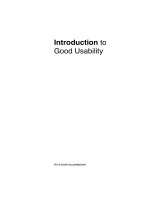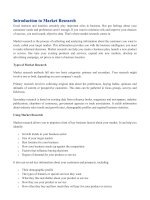Introduction to corporate finance booth cleary
Bạn đang xem bản rút gọn của tài liệu. Xem và tải ngay bản đầy đủ của tài liệu tại đây (6.89 MB, 1,565 trang )
INTRODUCTION TO
CORPORATE FINANCE
Laurence Booth • W. Sean Cleary
Contents
•
•
•
•
•
•
•
•
•
•
•
•
•
•
•
•
•
•
•
•
•
•
•
•
CHAPTER 1: An Introduction to Finance 03
CHAPTER 2: Business (Corporate) Finance 38
CHAPTER 3: Financial Statements 80
CHAPTER 4: Financial Statement Analysis and Forecasting 136
CHAPTER 5: Time Value of Money 221
CHAPTER 6: Bond Valuation and Interest Rates 281
CHAPTER 7: Equity Valuation 353
CHAPTER 8: Risk, Return, and Portfolio Theory 410
CHAPTER 9: The Capital Asset Pricing Model (CAPM)
(CAPM) 504
CHAPTER 10: Market Efficiency 618
CHAPTER 11: Forwards, Futures, and Swaps 663
CHAPTER 12: Options 717
CHAPTER 13: Capital Budgeting, Risk Considerations and Other Special Issues 781
CHAPTER 14: Cash Flow Estimation and Capital Budgeting Decisions 867
CHAPTER 15: Mergers and Acquisitions 937
CHAPTER 16: Leasing 992
CHAPTER 17: Investment Banking and Securities Laws 1015
CHAPTER 18: Debt Instruments 1042
CHAPTER 19: Equity and Hybrid Instruments 1088
CHAPTER 20: Cost of Capital 1153
CHAPTER 21: Capital Structure Decisions 1288
CHAPTER 22: Dividend Policy 1383
CHAPTER 23: Working Capital Management: General Issues 1457
CHAPTER 24: Working Capital Management: Current Assets and Current Liabilities 1531
CHAPTER 1 - An Introduction to Finance
www.bookfiesta4u.com
1-2
Contents
CHAPTER 1
An Introduction to Finance
Lecture Agenda
•
•
•
•
•
•
•
•
Learning Objectives
Important Terms
Finance Defined
Real versus Financial Assets
The Financial System
Financial Instruments and Markets
The Global Financial Community
Summary and Conclusions
– Concept Review Questions
CHAPTER 1 - An Introduction to Finance
www.bookfiesta4u.com
1-4
Contents
Learning Objectives
1.
2.
3.
4.
5.
6.
What finance is and what is involved in the study of finance.
How financial securities can be used to provide financing for
borrowers and simultaneously to provide investment
opportunities for lenders.
How financial systems work in general.
The channels of intermediation and the role played by
market and financial intermediaries within this system.
The basic types of financial instruments that are available
and how they are traded.
The importance of the global financial system.
CHAPTER 1 - An Introduction to Finance
www.bookfiesta4u.com
1-5
Contents
Key Terms
•
•
•
•
•
•
•
•
•
•
•
•
•
•
•
•
•
Bourse de Montréal
brokers
Canadian Trading and Quotation System Inc. (CNQ)
capital market securities
common share
corporate finance
Crown corporations
dealer or overover-the
the--counter (OTC) markets
debt instruments
equity instruments
exchanges or auction markets
finance
financial assets
financial intermediaries
fourth market
intermediation
investments
CHAPTER 1 - An Introduction to Finance
www.bookfiesta4u.com
1-6
Contents
Key Terms
•
•
•
•
•
•
•
•
•
•
•
•
•
•
•
•
•
market capitalization
market intermediary
marketable financial assets
money market securities
New York Stock Exchange (NYSE)
non--marketable financial assets
non
Ontario Securities Commission
preferred shares
primary markets
real assets
secondary markets
third market
Toronto Stock Exchange (TSX)
TSX Group Inc.
TSX Markets
TSX Venture Exchange
Winnipeg Commodity Exchange
CHAPTER 1 - An Introduction to Finance
www.bookfiesta4u.com
1-7
Contents
What Is Finance?
• Finance is the study of how and under what
terms savings (money) are allocated between
lenders and borrowers.
– Finance is distinct from economics in that it
addresses not only how resources are allocated but
also under what terms and through what channels
• Financial contracts or securities occur whenever
funds are transferred from issuer to buyer.
CHAPTER 1 - An Introduction to Finance
www.bookfiesta4u.com
1-8
Contents
The Study of Finance
• The study of finance requires a basic
understanding of:
– Securities
– Corporate law
– Financial institutions and markets
CHAPTER 1 - An Introduction to Finance
www.bookfiesta4u.com
1-9
Contents
Real Versus Financial Assets
• Real assets are tangible things owned by
persons and businesses
–
–
–
–
Residential structures and property
Major appliances and automobiles
Office towers, factories, mines
Machinery and equipment
• Financial assets are what one individual has lent
to another
– Consumer credit
– Loans
– Mortgages
CHAPTER 1 - An Introduction to Finance
www.bookfiesta4u.com
1 - 10
Contents
Assets and Liabilities of Households,
2005
Table 1-2 Assets and Liabilities of Households, 2005
Assets
$ Billion
Houses
1,086
Consumer Durables
435
Land
827
Real Assets
2,348
Deposits
683
Debt
114
Pensions and insurance
1,200
Shares
1,254
Foreign and other
72
Financial Assets
3323
Total Assets
5,671
Liabilities
$ Billion
Consumer credit
260
Loans
131
Mortgages
588
Total Liabilities
979
So urce: Statistics Canada. Natio nal B alance Sheet A cco unts, Quarterly Estimates, Fo urth
Quarter 2005. Ottawa: M inister o f Industry, 2006 (Catalo gue No . 13-214-XIE).
CHAPTER 1 - An Introduction to Finance
www.bookfiesta4u.com
1 - 11
Contents
The Financial System
Overview
• The household is the primary provider of funds to
businesses and government.
• Households must accumulate financial resources throughout their
working life times to have enough savings (pension) to live on in
their retirement years
• Financial intermediaries transform the nature of the
securities they issue and invest in
• Banks, trust companies, credit unions, insurance firms, mutual
funds
• Market intermediaries simply help make markets work
• Investment dealers
• Brokers
CHAPTER 1 - An Introduction to Finance
www.bookfiesta4u.com
1 - 12
Contents
The Financial System
FIGURE 1-2
CHAPTER 1 - An Introduction to Finance
www.bookfiesta4u.com
1 - 13
Contents
The Financial System
Channels of Intermediation
• Funds can be channeled from saver to borrower
in three ways:
– Direct intermediation (direct transfer from saver to
borrower – a nonnon-market transaction)
– Direct intermediation (a marketmarket-based transaction
usually through a market intermediary such as a
broker)
– Indirect claims through a financial intermediary
(where the financial intermediary such as a bank
offers depositdeposit-taking services and ultimately lends
those deposits out as mortgages or loans)
CHAPTER 1 - An Introduction to Finance
www.bookfiesta4u.com
1 - 14
Contents
Channels of Intermediation
FIGURE 1-3
CHAPTER 1 - An Introduction to Finance
www.bookfiesta4u.com
1 - 15
Contents
The Financial System
Financial Intermediaries
•
•
•
•
Banks and other deposit
deposit--taking institutions
Insurance companies
Pension Funds
Mutual Funds
CHAPTER 1 - An Introduction to Finance
www.bookfiesta4u.com
1 - 16
Contents
Financial Intermediaries
Canadian Chartered Banks
•
•
•
•
Banks take deposits from numerous depositors from across Canada
The deposits are ‘pooled’ in the Bank
The bank takes these pooled funds and lends them out to households and
businesses in the form of mortgages and loans
The bank transforms the original nature of the savers (depositors) money:
– Deposits are usually small in amount…face little or no risk, and depositors
expect to withdraw the amount at any time
– Loans and mortgages on the other hand usually have the following
characteristics:
• Large sums
• Borrowed for long periods of time
• Borrowed for risky purposes.
•
Banks can perform this transformation function because they become
experts at risk assessment, financial contracting (pricing the risk) and
monitoring the activities of borrowers.
CHAPTER 1 - An Introduction to Finance
www.bookfiesta4u.com
1 - 17
Contents
Financial Intermediaries
Canadian Chartered Banks
Table 1-3 Chartered Banks: Financial Statistics, 2005
Bank
Royal Bank of Canada
Canadian Imperial Bank of Commerce
(CIBC)
Bank of Nova Scotia
TD Canada Trust
Bank of Montreal
National Bank
Revenue
Assets
Profits
($ million) ($ million) ($ million)
29,403
469,521
3,387
18,677
18,332
18,665
15,138
5,320
280,370
314,025
365,210
297,532
107,598
-32
3,209
2,229
2,400
855
So urce: B M O Investo rLine website: www.bmo investo rline.co m, Octo ber 31, 2006.
CHAPTER 1 - An Introduction to Finance
www.bookfiesta4u.com
1 - 18
Contents
Financial Intermediaries
Insurance Companies
– Insurers sell policies and collect premiums from customers
based on the pricing of those policies given the probability of a
claim and the size the policy and administrative fees.
– They invest the premiums so that the accumulated value in the
future will grow to meet the anticipated claims of the
policyholders.
– In this way, unsupportable risks (such as the death of wage
earner or the burning down of a business) are shared among a
large number of policyholders through the insurance company.
– Insurance allows households, business and government to
engage in risky activities without having to bear the entire risk of
loss themselves.
CHAPTER 1 - An Introduction to Finance
www.bookfiesta4u.com
1 - 19
Contents
Financial Intermediaries
Insurance Companies
Table 1-4 Insurance Companies: Financial Statistics, 2005
Insurer
Manulife Financial
Sun Life Financial
Great-West Lifeco
ING Canada
Revenue
Assets
Profits
($ million) ($ million) ($ million)
32,187
322,171
3,294
21,871
171,850
1,867
23,883
102,161
1,775
4,446
9,926
782
So urce: Data fro m B M O Investo rLine website: www.bmo investo rline.co m, Octo ber 31, 2006.
CHAPTER 1 - An Introduction to Finance
www.bookfiesta4u.com
1 - 20
Contents
Financial Intermediaries
Pension Plan Assets
– Individuals and employers make payments over the
entire working life of a person with those funds
invested to grow over time.
– Ultimately, the accumulated value in the pension can
be used by the person in retirement.
– Pension plans accumulate considerable sums of
money, and their managers invest those funds with
long--term investment time horizons in diversified
long
portfolios of investments. These investments are a
major source of capital, fuelling investment in
research and development, capital equipment,
resource exploration and ultimately contributing in a
substantial way to growth in the economy.
CHAPTER 1 - An Introduction to Finance
www.bookfiesta4u.com
1 - 21
Contents
Financial Intermediaries
Pension Plan Assets
Table 1-5 Pension Plan Assets, 2005
Pension Plan Managers
Caisse de depot et placement du Quebec
Canada Pension Plan (CPP)
Ontario Teachers (Teachers)
Ontario Municipal Employees (OMERS)
Net Assets
($ billion)
216.1
98.0
96.1
41.6
* The Caisse manages the investments o f several pensio n plans.
CHAPTER 1 - An Introduction to Finance
www.bookfiesta4u.com
1 - 22
Contents
Financial Intermediaries
Canadian Mutual Fund Assets
• Mutual funds give small investors access to diversified,
professionally--managed portfolios of securities.
professionally
• Small investors often do not have the funds necessary to
invest directly into marketmarket-traded stocks and bonds.
• This is called denomination intermediation because the
mutual fund makes investments available in smaller,
more affordable amounts of money.
• Canadian indirect investment in the markets through
managed products such as mutual funds and segregated
funds has grown exponentially.
(see Figure 11-4 on the next slide)
CHAPTER 1 - An Introduction to Finance
www.bookfiesta4u.com
1 - 23
Contents
Financial Intermediaries
Canadian Mutual Fund Assets
FIGURE 1-4
CHAPTER 1 - An Introduction to Finance
www.bookfiesta4u.com
1 - 24
Contents
The Financial System
The Major Borrowers
• Public Debt
– Governments
•
•
•
•
Federal
Provincial
Municipal
Crown Corporations
• Private Debt
– Households
– Non
Non--financial Corporations
CHAPTER 1 - An Introduction to Finance
www.bookfiesta4u.com
1 - 25
Contents









